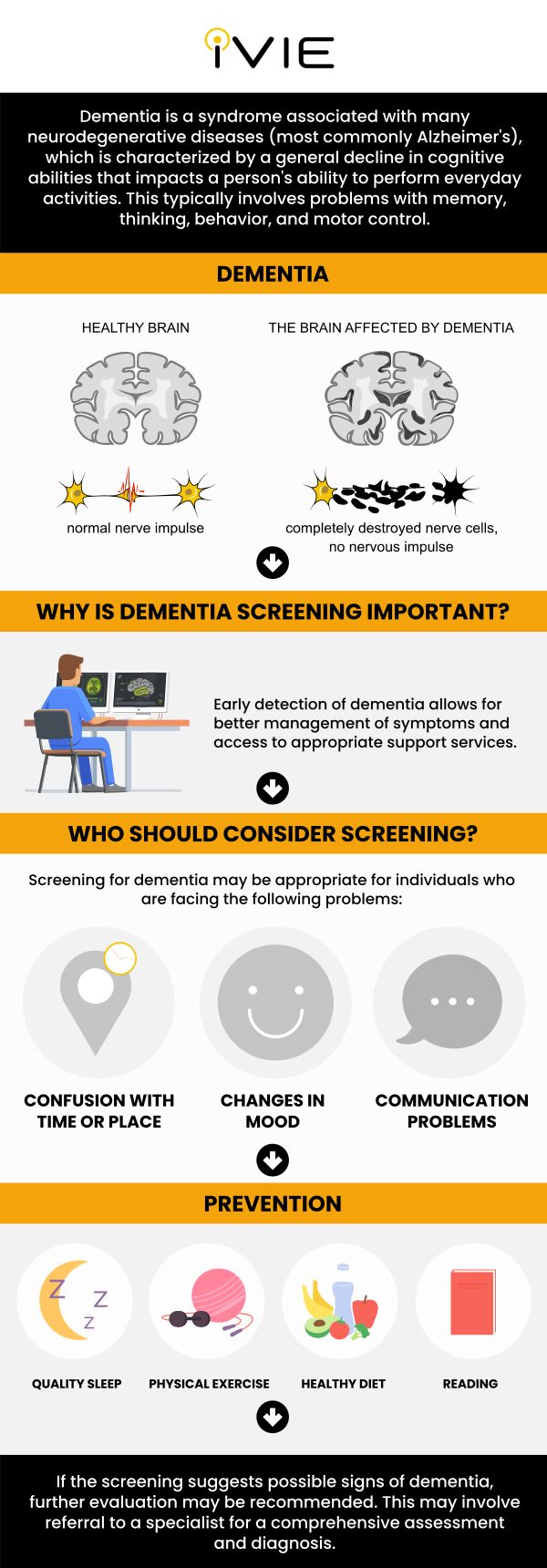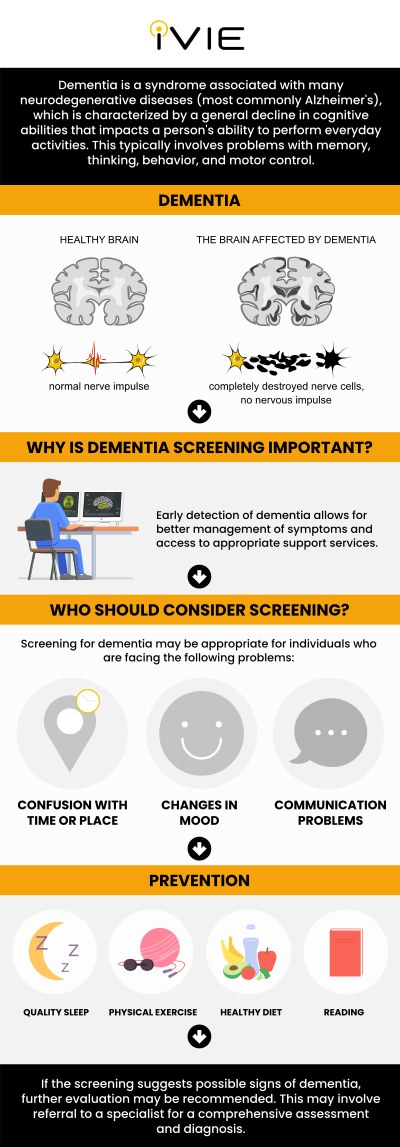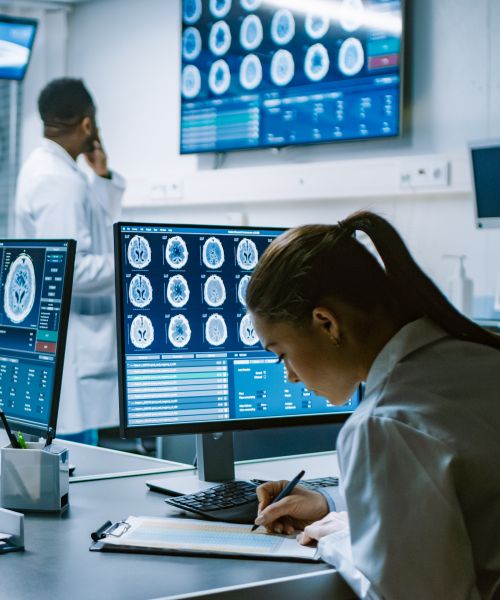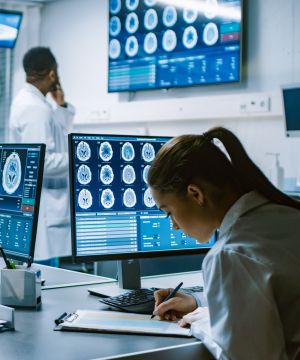The Role of MRI in Early Detection of Dementia
MRI plays a crucial role in the early detection of dementia by providing detailed images of brain structures and identifying early signs of atrophy and other abnormalities. This advanced imaging technique helps healthcare professionals diagnose dementia sooner, allowing for timely interventions and better management of the condition. Meet Dr. Kourosh Naini and get your dementia screening at the iVIE MRI Screening Center. For more information, contact us or book an appointment online. We are located at 11600 Washington Pl, Suit A, Culver City, CA 90066.


Table of Contents:
How effective is MRI in detecting early signs of dementia?
What are the key MRI indicators that suggest the onset of dementia?
Can MRI predict dementia before symptoms?
Are MRI scans reliable for early dementia detection?
Magnetic Resonance Imaging, or MRI, is a crucial component of the services provided by Kourosh Naeini at iVIE MRI Screening Center. Recognized as a powerful, non-invasive medical imaging technique, MRI is vital in the early detection and precise diagnosis of dementia, amongst other neurological conditions.
At iVIE MRI Screening Center, our MRI technology uses magnetic fields and radio waves to create comprehensive images of the brain, providing unparalleled insights into the internal structure and function of the human body. This tool is invaluable in diagnosing many neurological conditions, including dementia.
By using MRI, we can reveal brain size and structural changes often indicative of dementia, such as shrinkage in the hippocampus – a critical brain area for memory that is notably affected in the early stages of Alzheimer’s disease. MRI also offers valuable information about disease severity by identifying brain atrophy. Moreover, MRI can assess white matter integrity, vital for communication between different brain regions, and can be disrupted by dementia.
Functional MRI (fMRI) is also used to measure brain activity and assess functional connectivity between different brain regions. This can help identify alterations linked to cognitive and behavioral changes in dementia. Despite MRI’s utility, it is important to note that it is not a definitive diagnostic tool for dementia and should not be solely relied upon.
The use of MRI at iVIE MRI Screening Center allows us to detect early signs of dementia, facilitate timely interventions, guide treatment decisions, and contribute to improved patient outcomes. But rest assured, we recognize that MRI is most effective when used as part of a broader diagnostic approach.
At iVIE MRI Screening Center, we highly value the use of advanced diagnostic tools such as magnetic resonance imaging (MRI) to evaluate neurological conditions, including dementia. Our clinic understands the importance of an early and accurate diagnosis of dementia, which is characterized by memory loss and cognitive decline. To this end, we use MRI scans to identify the key indicators that may suggest the onset of the condition.
One primary sign we look for is the atrophy of the hippocampus, a region of the brain vital for memory and learning. The degree of hippocampal atrophy, particularly in the CA1 subregion, can be associated with the extent of cognitive impairment.
We also identify the enlargement of the brain’s ventricles, which is often observed in dementia patients. This enlargement is a result of brain tissue loss, particularly in the white matter around the ventricles.
Our practice uses MRI scans to detect white matter hyperintensities, which are structural abnormalities in the brain’s white matter tracts and are often associated with cerebrovascular disease, a major risk factor for dementia.
We also look for reductions in gray matter volume, especially in the frontal and temporal lobes. Decreases in gray matter volume suggest neuronal loss or damage, which is indicative of dementia.
At iVIE MRI Screening Center, we utilize advanced MRI techniques to detect the presence of amyloid plaques and tau tangles, the pathological hallmarks of Alzheimer’s disease. These are closely associated with cognitive decline and dementia.
Another MRI technique we use is Diffusion Tensor Imaging (DTI), which measures the diffusion of water molecules in the brain. Changes in water diffusion can point to alterations in white matter integrity and connectivity.
Lastly, we identify the presence of microbleeds and silent brain infarcts that are associated with an increased risk of dementia. Microbleeds are small, dot-like lesions in the brain, while silent brain infarcts are tiny strokes that often go unnoticed.
In conclusion, the combination of hippocampal atrophy, ventricular enlargement, white matter hyperintensities, gray matter reductions, the presence of amyloid plaques and tau tangles, DTI changes, and the presence of microbleeds or silent brain infarcts can all point to the onset of dementia. These indicators are vital for guiding further diagnostic workups, such as neuropsychological testing and biomarker analysis. However, we always interpret these MRI findings in the context of a patient’s overall clinical picture as they can also occur in other neurological conditions.
This cutting-edge imaging technique is instrumental in detecting subtle changes in brain structure and function, which can be indicative of the early stages of dementia.
Dementia is a progressive neurodegenerative disorder, and our team at iVIE MRI Screening Center understands the importance of early detection in managing the disease more effectively and slowing its progression. The use of MRI allows us to potentially predict the development of dementia even before any symptoms appear.
At iVIE MRI Screening Center, we use MRI to identify structural changes in the brain, such as shrinkage of specific brain regions like the hippocampus and the temporal lobes, commonly seen in Alzheimer’s patients. These changes can be due to the accumulation of amyloid plaques and tau tangles, which are characteristic features of Alzheimer’s disease.
Our team also uses MRI to detect functional changes in the brain related to dementia. For instance, reduced blood flow and metabolism in certain brain regions, indicative of disrupted neural connections and impaired brain activity, can be identified. Furthermore, the presence of beta-amyloid plaques, which accumulate years before symptoms appear, can also be detected using this technique.
Another important application of the MRI Screening Center is in identifying changes in the brain’s white matter. These changes, known as white matter hyperintensities, are often seen in older adults and have been linked to cognitive decline. Through MRI, we aim to predict the risk of developing dementia by examining these changes.
By combining structural and functional MRI data with other risk factors like age, genetics, and lifestyle factors, we hope to estimate the likelihood of developing dementia in the future. However, while MRI scans provide valuable information, they are not definitive proof of dementia. They are used in conjunction with other diagnostic tools and assessments.
In conclusion, Dr. Kourosh Naeini and his team at iVIE MRI Screening Center believe in the potential of MRI to play a significant role in the early detection and prevention of dementia. By identifying individuals at high risk, it may be possible to implement interventions to slow or prevent the progression of the disease. We are dedicated to ongoing research to fully understand the role of MRI in dementia prediction and to refine our MRI techniques. Our goal is to develop personalized strategies for preventing or delaying the onset of dementia.
An MRI is a non-invasive procedure that uses powerful magnets, radio waves, and a computer to generate detailed images of the body’s internal structures, and it is widely used to diagnose a variety of medical conditions. One such condition that MRI is potentially adept at identifying is dementia.
Dementia represents a range of medical conditions characterized by a decline in memory, language, problem-solving, and other cognitive skills that affect a person’s ability to perform everyday activities. Alzheimer’s disease is the most common type of dementia. MRI scans can reveal valuable information about brain structure and function, making them a useful tool for detecting and assessing dementia.
We employ various MRI techniques at iVIE MRI Screening Center Diagnostic Imaging to acquire the most comprehensive picture of your brain health. For example, Functional MRI (fMRI) scans measure brain activity by tracking changes in blood flow, revealing altered brain activation patterns in individuals with dementia. Additionally, Diffusion Tensor Imaging (DTI), a specialized MRI technique, assesses the movement of water molecules in the brain, detecting changes in white matter integrity associated with cognitive decline and dementia.
However, while MRI scans can detect these physical changes, they cannot conclusively diagnose dementia, especially in its early stages. The physical changes detected can be caused by a variety of factors, some of which may not be related to dementia. Therefore, at iVIE MRI Screening Center Diagnostic Imaging, we believe in a comprehensive approach to diagnosing dementia. This includes cognitive tests, physical examinations, and personal history assessments, along with brain imaging techniques like MRI scans.
In conclusion, while MRI scans provide crucial information, they should not be used as the only tool for diagnosing dementia, especially in its early stages. Dr. Kourosh Naeini and his team are committed to continual research to improve the reliability and accuracy of MRI scans for early dementia detection, offering patients the highest standard of care. For more information, contact us or book an appointment online. We are located at 11600 Washington Pl, Suit A, Culver City, CA 90066. We serve patients from Culver City Los Angeles CA, Downtown LA, Beverly Hills CA, Marina del Rey CA, Venice CA, Santa Monica CA, and surrounding areas.


Additional Services You May Need
▸ Dementia Screening
▸ Aneurysm Screening
▸ Spine MRI
▸ Whole Body MRI Screening
▸ MRI Brain Screening
▸ Brain PET
▸ Work/Sport Spine Injury Diagnosis
▸ Work/Sport Brain Injury Diagnosis
▸ Whole Body PET For Cancer
▸ MRA Brain Screening


